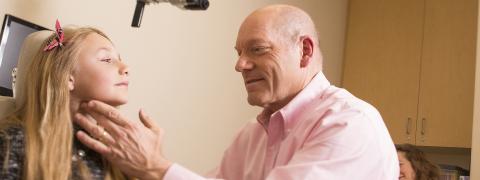
If you are, or have been, the parent of a young child, you’ve likely stood by as they experienced a painful ear infection. And while having one, or a few, during a child’s first five years is normal, having chronic ear infections or infections that won’t clear up is not something to ignore. While chronic middle ear infections are more common in young children without fully developed eustachian tubes, they can also occur in teens or adults.
When ear infections become chronic, they can lead to hearing loss, poor school performance, behavior or speech problems. For these reasons, doctors like to step in when ear infections become persistent. Each year, more than half a million ear tube surgeries are performed on children, making it the most common childhood surgery performed with anesthesia. While it is a simple procedure, it does require precision and kids are squirmy, necessitating the use of anesthesia.
Why treat ear infections with ear tubes?
Ear tubes are ventilation tubes that an otolaryngologist (also called an Ear Nose and Throat or ENT doctor) places in the middle ear to enable air flow. An ENT will determine whether short-term or long-term tubes are warranted. Short- term tubes are smaller and typically stay in place for six to eighteen months before falling out on their own. Long-term tubes are larger and have flanges that secure them in place and typically require an otolaryngologist to remove.
Inserting ear tubes can help:
- Reduce the risk of future ear infection
- Restore hearing loss caused by middle ear fluid
- Improve speech and balance problems
- Improve behavior and sleep problems caused by chronic ear infections
RELATED: Understanding child speech development
Surgery?! On my child!
While it is called ear tube ‘surgery,’ inserting ear tubes is an outpatient surgical procedure. A small incision is made in the ear drum or tympanic membrane, the fluid behind the ear drum (in the middle ear space) is suctioned out, and the tube is inserted in the hole. The procedure is called a myringotomy.
Typically, a general anesthesia is used. However, older kids or adults may opt to do the procedure without a general. The procedure typically lasts 15 minutes and there is little to no pain or soreness. With anesthesia, the biggest post-surgery challenge is grogginess and/or nausea. Sometimes, an antibiotic ear drop may be prescribed for post-surgery care.
RELATED: Drop the Q-tip! Why ENTs are begging you to leave your ears alone
Life with ear tubes
After coming out of anesthesia, your child can resume their normal activities right away. Even bathing and swimming routines do not need to be amended (there was a time when head bands or ear plugs were recommended for water contact, but this is no longer the case).
This is a very common surgery and complications are rare. When they do occur, they include:
- Perforation: The hole in the tympanic membrane (ear drum) does not close when the tube is removed or comes out. The hole can be patched through a surgical procedure called a tympanoplasty or myringoplasty.
- Infection: Ear infections can still occur with a tube in place. These infections are infrequent, do not cause hearing loss (because the infection drains out), and may go away on their own or be treated effectively with antibiotic ear drops.
- Ear tubes come out too early or stay in too long: If an ear tube expels from the ear drum too soon (which is unpredictable), fluid may return and repeat surgery may be needed. Ear tubes that remain too long may require removal by an otolaryngologist.
Are tubes the right choice?
Thinking about surgery on our children is always scary, but ear tube surgery is common and simple and can drastically improve the quality of life for the child and their worried parents. For a personal evaluation, see the experts at Sierra Nevada, Ear, Nose & Throat. They can diagnose your child’s ear condition and determine an appropriate care plan. Call 775.883.7666 for an appointment.
- Education


